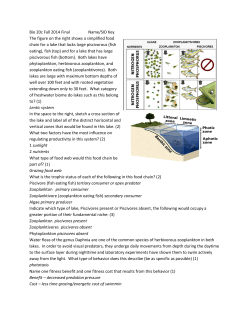
Division: Ochrophyta
4/28/2015 Order Laminariales: Division: Ochrophyta- 16,999 species Class: Phaeophyceae – 2,060 species Order: 6. Laminariales- 148 species - Saxicolous - Sporangia always unilocular - Most have sieve cells/elements - Pheromone released by female gametes lamoxirene Genus: Macrocystis Nereocystis Pterogophora Egregia Postelsia Alaria 1. Life History and Reproduction 2. Macrothallus Construction: 3. Growth 2 14 Microscopic gametophytes Life History of Laminariales Diplohaplontic Alternation of Generations: organism having a separate multicellular diploid sporophyte and haploid gametophyte stage 3 4 1 4/28/2015 General Morphology: All baby kelps look alike Intercalary growth 6 Meristodermal growth Meristoderm/outer cortex – outermost cells (similar to cambia in land plants) Inner cortex – unpigmented cells Medulla – contains specialized cells (sieve elements/hyphae) Meristodermal growth gives thallus girth (mostly) “transition zone” Periclinal vs. Anticlinal cell division: • Periclinal = cell division parallel to the plane of the meristoderm girth • Growth in both directions away from meristem • Usually between stipe and blade (or blade and pneumatocyst) 7 •Anticlinal = cell division perpendicular to the plane of the meristoderm height 8 2 4/28/2015 Anticlinal Pattern of cell division perpendicular to surface of algae. Phaeophyceae Morphology of intercellular connections Only alga to transport sugar/photosynthate in sieve elements Periclinal Cell division parallel to surface of plant. Plasmodesmata = connections between adjacent cells, formed during cell division - Used for cell-to-cell transport of photosynthetic products and cell communication 9 Transport: Transport in Plants vs. Algae completely independent evolutionary origins sieve elements, sieve cells, trumpet hyphae • Transport photosynthetic products • Outgrowths of cortex cells that grow into the medulla • Don’t divide again after formation, so they get drawn out into long thin “trumpets” = trumpet hyphae • Sieve plates are specialized plasmodesmata between the sieve elements that allow transport of sugars between cells •Important because kelps are so large: light levels don’t reach lower portions Plants • Have water and sugar conducting cells Algae • Only conduct sugars and some nutrients • Xylem non-living •All cells living • Sieve elements alive • Sieve elements alive • Sieve elements lack organelles • Sieve elements lack organelles except mitochondria • Have companion cells 11 • No companion cells 12 3 4/28/2015 Kelp Evolution : Evidence on NE Pacific Origin Kelp Distribution 1. Kelp forests are found in shallow rocky habitats along temperate coasts throughout the world 2. Area world ocean covered by kelp forest is comparable to that covered by coral reefs 3. Kelps thrive in cool nutrient rich water-> explains why the most extensive kelp forests are found on western continental margins, where extensive upwelling occurs 4. Not found at low latitudes because intolerant of H2O temps above 20 deg C (metabolic effect or because of grazers/pathogens…) M.H. Graham Kelp Evolution : Evidence on NE Pacific Origin How did kelp get to the Southern Hemishere? Theory 1: It floated Earliest kelps: •Simple morphology •Dichotomous branching •Pneumatocysts present •Hybrid of Macrocystis and Pelagophychus •Found in So Cal Fossils •Dated back to 20 mya Obligate species evolved at the same time: •Sea Otters •Steller’s Sea Cow •Abalone •Sea Urchins 4 4/28/2015 How did kelp get to the Southern Hemishere? Theory 2: It traveled far enough to reach cold water refugia Eisenia galapagensis Foundation Species- a single species that defines much of the structure of a community by creating locally stable conditions for other species, and by modulating and stabilizing fundamental ecosystem processes Paul Dayton 1972 Macrocystis pyrifera = foundation species • Influence water motion • Dispersal of plankton •Sea otters wrap themselves with this kelp to keep from floating away while sleeping •Dissolved matter from these kelps = important food source 20 5 4/28/2015 Macrocystis pyrifera = the giant kelp • Major canopy kelp, up to 60 m in length • Capable of high growth rates: 1-2 ft/day! • Perennial, but individual blades only last ~ 2 - 6 Months •High turnover rates ( compared with trees and coral reefs) f ) • Apical scimitar blade at growing tip • Intercalary meristem between blade and pneumatocyst •Sporophylls- above holdfast, no pneumatocysts,chemically defended •Hapterous holdfast 21 Macrocystis pyrifera = the giant kelp Macrocystis pyrifera = the giant kelp vs. M. integrifolia Northern limit- set by hydrodynamic forces Demes et al. 2009 Southern limit – set by lack of substrate and temperature and nutrient conditions 23 6 4/28/2015 Kelp forests vulnerable to disturbance and local extinction How far do spores travel? Removal by storm waves Poor environmental conditions Grazer outbreaks Imbreeding Nereocystis luetkeana = the bull kelp • Major canopy species • Hapterous holdfast • Stipe up to 50 m long!! • Single big pneumatocyst filled with carbon dioxide and monoxide • Annual!!! Most growth March-Sept (~200 days to get that big…can grow >1 ft/day!) •Sori on main blade, pop out and are negatively buoyant WHY?? 28 7 4/28/2015 Nereocystis luetkeana = the bull kelp Pteryogophora californica = the walking kelp Morphological plasticity: • Low flow environments– ruffled blades (increases motion and therefore nutrient uptake, broad blades for light interception) • Understory kelp • High flow environments- flat and narrow (less drag so not ripped out and no shading) • Woody stipe, terminal vegetative blade and lateral sporophylls • Perennial – up to 25 years old! • Growth rings in stipe, just like trees blade sporophylls 29 Egregia menziesii = feather boa kelp 30 Egregia menziesii = feather boa kelp Perennial Mid-low intertidal Max frond # per plant = 50 Max # fronds per m2= 150 • Midrib = rachis • Sporophylls – deeper brown color; l ; shorter sh t and d more m narrow than vegetative blades and dispersed among them • Intercalary meristem in upper portion of rachis •Northern morph and southern morph 32 5 8 4/28/2015 Postelsia palmaeformis = the sea palm Postelsia palmaeformis = the sea palm • Grows in high wave exposed habitats • Grows in high wave exposed habitats • Sensitive to desiccation in high zone • Blade surface with deep longitudinal grooves •Does Does not get enough light if too submerged in low zone • Sporangia in linear sori lining grooves • Zoospores released and drip down grooves (1-5m away) land on: • Mussels • Bare rock • Below mussels 35 • Winter storms rip out mussels which opens up space for light 36 9 4/28/2015 Kelp Harvest History sporophylls Alaria -intertidal to 10 meters -edible -affected by climate change disappeared from the English Channel -17th century – kelp ash – French peasants used for glazing pottery and making low quaility glass -1811 – discovery of iodine in kelps – used to treat goiters – enlargements of the thyroid gland blade g - 2004-industrial use is for alginates-San Diego based firm, ISP alginates (AKA Kelco) largest in the world 37 Kelp Harvest- 89 state-defined kelp beds - 38 available for lease but only 9 are leased -Harvest regulated by CA DFG: can cut only upper 1.2 m -Abalone growers lease 7 beds - The Nature Conservancy leased 2 kelp beds-2,710 acres $5 800 for 3 years $5,800 -Collaborative research by Kendra Karr UCSC and The Nature Consevancy found that for juvenile rock fish better to half-harvest two kelp forest patches than to whole- harvest one patch 38 Laminariales Family: Laminariaceae Macrocystis, Nereocystis, Pelagophycus, Postelsia, Laminaria Alariaceae Stipe derived sporophylls Alaria, Pterogophora, Undaria, Lessoniopsis, Pleurophycus (but not this one) Lessoniaceae Eckolonia, Egregia, Eisenia, Lessonia Costariacea Flattened stipe with a perforated or reticulate blade Costaria, Agarum, Dictyoneurum, Lane et al. 2006 40 10
© Copyright 2025











